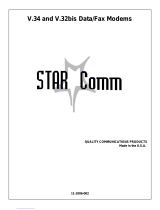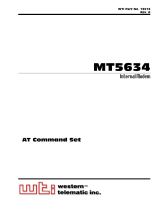
Chapter 2 – AT Commands
Multi-Tech Systems, Inc. AT Commands Reference Guide (S000273F) 14
Command: +GCI Country/Region of Installation
Description: This extended syntax command selects and indicates the region/country of installation for
the modem. The parameter selects the settings for any operational parameters that need
to be adjusted for national regulations or telephone networks.
Syntax: +GCI=<region_code>Defined Values: <region_code>Example: Euro/Nam = B5.
For a list of regions/countries approvals and codes, see the Multi-Tech Web site at:
http://www.multitech.com/PRODUCTS/Info/approvals
Default: If the modem is specified for use in only one country, the country code is the default.
Otherwise, the default is defined by the OEM. The factory default is B5.
Report Commands: +GCI? Reports current or selected values.
+GCI=? Reports supported range of parameter values.
Command: +MS= Modulation Selection
Values & Default: See description.
Description: This extended-format command selects modulation and, optionally, enables or disables
automode, specifies the lowest and highest connection rates, selects µ-Law or A-Law
codec type, and specifies the highest transmit rate using one to five subparameters.
The command format is:
+MS=[+MS=[<carrier>[,<automode>[,<min_TX_rate>[,<max_TX_rate>[,min_RX_rate>[,<max_RX_rate>]]]]]]
Subparameters that are not entered retain their current value. Commas separate optional
subparameters and should be inserted to skip a subparameter. Example: +MS=,0,<CR>
disables automode and keeps all other settings at their current values.
Subparameters: mod – A decimal number that specifies the preferred modulation (automode enabled) or
the modulation to use in originating or answering a connection (auto-mode disabled).
+MS Command Supported Rates
Modulation
<carrier> Possible (<min_rx_rate>,<max_rx_rate>,(<min_tx_rate>), and
<max_tx_rate>) Rates (bps)
Bell 103 B103 300
Bell 212 B212 1200 Rx/75 Tx or 75 Rx/1200 Tx
V.21 V21 300
V.22 V22 1200
V.22 bis V22B 2400 or 1200
V.23 V23C 1200
V.32 V32 9600 or 4800
V.32 bis V32B 14400, 12000, 9600, 7200, or 4800
V.34 V34 33600, 31200, 28800, 26400, 24000, 21600, 19200, 16800, 14400,
12000, 9600, 7200, 4800, or 2400
V.90 V90 56000, 54667, 53333, 52000, 50667, 49333, 48000, 46667, 45333,
44000, 42667, 41333, 40000, 38667, 37333, 36000, 34667, 33333,
32000, 30667, 29333, 28000
V.92
downstream V92 same as V.90 above
V.92
upstream V92 48000, 46667, 45333, 44000, 42667, 41333, 40000, 38667, 37333,
36000, 34667, 33333, 32000, 30667, 29333, 28000, 26667, 25333,
24000
Note: Some <carrier> values may not be supported by certain model models.
automode – An optional numeric value that enables or disables automatic modulation
negotiation using V.8bis/V.8 or V.32bis Annex A. The options are:
0 = Disables automode
1 = Enables automode (default)
<min_rx_rate> and <max_rx_rate>
Numeric values which specify the lowest (<min_rx_rate>) and highest
(<max_rx_rate>) rate at which the modem may establish a receive connection. May
be used to condition distinct limits for the receive direction as distinct from the
transmit direction. Values for this subparameter are decimal encoded, in units of bit/s.
The possible values for each modulation are listed in the table above. Actual values
will be limited to possible values corresponding to the entered <carrier> and fall-back
<carrier> as determined during operation. (Default = lowest (<min_rx_rate>) and
highest (<max_rx_rate>) rate supported by the selected carrier.)
<min_tx_rate> and <max_tx_rate>
Numeric values which specify the lowest (<min_tx_rate>) and highest
(<max_tx_rate>) rate at which the modem may establish a transmit connection. Non-
zero values for this subparameter are decimal encoded, in units of bit/s. The possible
values for each modulation are listed in the table above. Actual values will be limited
to possible values corresponding to the entered <carrier> and fall-back <carrier> as
determined during operation. (Default = lowest (<min_tx_rate>) and highest
(<max_tx_rate>) rate supported by the selected carrier.)





















